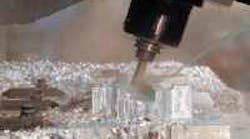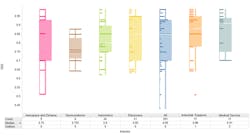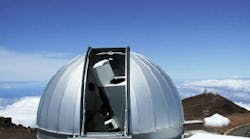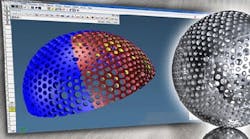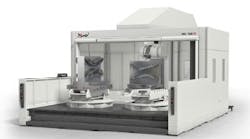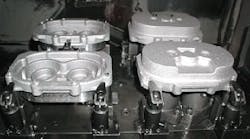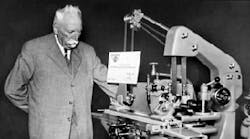Today, landing and keeping an aerospace contract requires that a shop has the capacity and capability to do the work.
By using Haas VR-11 five-axis VMCs, Aircraft Engineering is able to machine parts like this emergency escape hatch component in fewer setups.
Frank Escobar checks a completed emergency escape hatch upper sill that was machined on one of Aircraft Engineering's three Haas VR-11s.
The long travels of the Haas VF-10 combined with its 10,000-rpm spindle make quick work of parts like this 82-in.-long stringer splice.
The travels of the Haas VF-10 allow Aircraft Engineering to machine long parts like these 82-inch-long stringer splices with ease. Operator Steve Larabee monitors the process in the background.
Hal Purdy sets up a Haas VF-6 to machine emergency escape hatch brackets. The large table of the machine allows Aircraft Engineering to machine nine pieces at a time for high productivity.
Henry Bustamante monitors a job on one of Aircraft Engineering's three Haas VR-11 five-axis VMCs.
Aircraft Engineering currently has nine Haas machining centers on its shop floor, with more to come.
As more shops enter the fray for a slice of the aerospace pie, manufacturers like Boeing, McDonnell Douglas, and Martin Marietta are looking for suppliers that can provide the high accuracies and speed required for most aerospace jobs. In addition, these firms have to be able to handle just about any job that comes their way, so capacity and capability are critical.
One manufacturer that would know is Aircraft Engineering Corp. of Paramount, Calif. AEC has been a major supplier to the aerospace industry since 1959, primarily as a tooling house, building aircraft assembly tools, fixtures, and ground-support systems. But tooling is typically a one-shot deal. Once the tools are made, the job is done until a new aircraft design is ready for implementation.
To supplement its tooling work, AEC decided to diversify its operations and manufacture production airframe parts. Up to that point, only about five percent of AEC's work had been production, notes Bob Jeppesen, AEC's marketing manager. "Our big concern was that, if we were going to get into the production atmosphere and get real serious about it, we had to get into high speed [machining]."
According to Cliff Kenney, AEC's procurement manager, "Speed doesn't buy you much in tooling, because you're talking one part. By the time you get the bugs worked out so you can run it up to high rpm, you're done." With production parts, however, high speed and reduced cycle times are required to keep the price per part competitive. "We knew we couldn't run the parts fast enough on our old machines," Kenney says. "They just wouldn't cut it. It was obvious we had to do something."
Longer machines, higher accuracies
At present, about 50% of AEC's business is machining production airframe parts, and that percentage is increasing. The company wants to position itself as a first-call supplier for major manufacturers such as Boeing and Lock-heed/Martin. To this end, AEC is buying machines with longer travels and certifying their accuracy.
Over the past year and a half, the firm has slashed its cycle times while meeting the high production rates and quality levels required by its customers. AEC attributes much of this success to recent equipment procurements: It has bought larger machines to get work that some smaller shops can't do. For example, AEC has added nine vertical machining centers from Haas Automation Inc., Oxnard, Calif., including three VR-11 five-axis profiling VMCs.
"Mom and pop shops can buy smaller machines like the VF-1 or VF-2," explains Kenney, "but they don't have the funds to buy the larger VF-6s, 7s, 8s and 10s. We're trying to keep more of our machines in that higher end."
Kenney also notes the importance of X travel length: "We've got those 120-in. VF-10s and VR-11s, and we can run a long part that nobody else can really run in a timely manner. We've run parts over ten feet long in our VF-10," Kenney continues. "They've enabled us to get more work."
In addition, says Kenney, the company has changed how it buys equipment. "The mentality used to be: Get me a contract, and I'll buy a machine to do it," he explains. "Now, if you don't have the machines on the floor, you don't get the contract. So, either you're staffed and ready to run, or you're not going to get the work."
However, as important as meeting production schedules is to AEC, the most critical factor influencing its equipment purchases is accuracy. "One of the things we're working on," Kenney says, "is buying the parts directly off the machine. Right now, the parts go from machining to quality control, where they're inspected 100%. By using probe systems and in-process inspection, we hope to reduce much of the inspection process. We won't eliminate it all — the part still has to be inspected — but we won't have to touch every dimension, every hole," Kenney says. "There aren't many people in the world who are certified to do that for Boeing, and we're close."
Because Boeing is one of its primary customers, AEC is in the process of qualifying its Haas machines in compliance with Boeing's ATA standards (a set of standards used to determine the level of accuracy and repeatability achievable by a particular machine at a particular supplier). Consisting primarily of a ball bar test, laser calibration of the machine, and a test plate, these standards determine the level of work — labeled for example, very critical, critical, etc. — Boeing will release to a certain supplier.
According to AEC's SPC Administrator Werner Van Raay: "What's most important here isn't the laser cal, the ball bar, or any of the other tests; it's the plate. The plate establishes where you are on Boeing's scale as far as accuracy and capability. The test plate is the thing that says, 'This is what you're qualified to do.' The tighter the tolerance on the plate, the higher you get on Boeing's list."
He continues: "I want to qualify as many machines as I can, so that when Boeing looks at our list it says, 'Okay, this is AEC's capability, and man, look at all the machines its got.'" At present, AEC has qualified all nine of its Haas machines for ATA, as well as five other machines. "We probably have more ATA approved machines than any other shop in the U.S.," estimates Jeppesen. "We want to really know what the capabilities of the machines are, so that we can reduce inspection, make parts a little faster, and know that the parts are right," explains Van Raay. "As far as the Haas machines go, they're extremely accurate. We even had one Haas that pointed out problems with our CMM. We had a test plate off the VF-6 that kept showing a pattern that was out of square. We called Haas, and they checked the machine and proved it was in square. It turned out the CMM had settled and was out of square."
Adding machines
According to AEC, it looked at several manufacturers before investing in Haas CNC machines. Price, availability, high speed, and service were some of the key factors in its purchasing decision.
"We knew we were going to add some machines," Kenney says, "and I didn't want to be dependent on Japan or the East Coast for parts and service."
A heavy influx of orders for production parts necessitated that AEC quickly add equipment to its machine arsenal. The company purchased its first Haas machine — a VF-6 with 64 3 32 3 30 in. travels — in June of 1996, and has since added a VF-1, a VF-3 with a Haas Automatic Pallet Changer, a VF-7, a VF-8, a VF-10, and three VR-11 five-axis profiling VMCs. Five more machines were scheduled for delivery this year, but the recent downturn in the industry has temporarily put things on hold. AEC's ability to quickly ramp-up its production capability is helping the company successfully weather the current slow-down.
For added flexibility, most of AEC's Haas machines come with high-torque 10,000 rpm spindles, expanded memory, probe-ready packages, 1,000-block/sec processors, and 4th and 5th-axis controls.
"We have them all set up so we can do anything with them," Kenney states. "We learned a long time ago that it's cheaper to buy features now, than try to retrofit them later."
Kenney reflects that, "With some of the other manufacturers, you can't get delivery on big machines for 14 to 16 months. We couldn't wait. You have to machine parts when the orders are there, or you lose out. We knew how long it would take us to run the parts on our existing equipment, and we knew we had to do it faster if we wanted to be in a competitive position in the marketplace."
